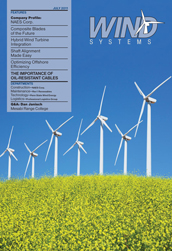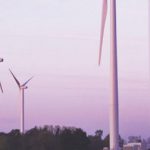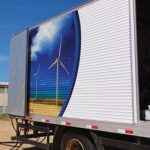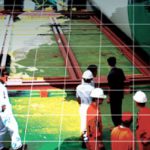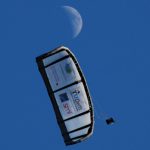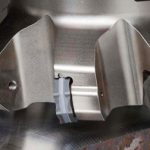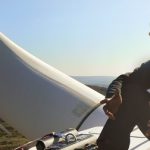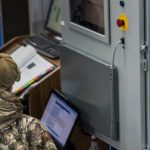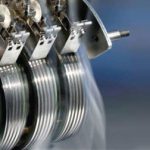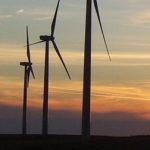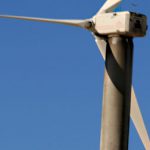If you ask a wind turbine blade manufacturer what he or she is most concerned about, they will tell you without hesitation that it is getting to market faster. The vast majority of firms are expressing the need to produce more blades in less time. They are setting the bar very high, in fact, seeking to produce blades sometimes two to three times faster than is now the case.
Indeed, current engineering and manufacturing processes typically entail numerous manual steps, including the creation of technical drawings based on sketches and paper-based data. Multiple verbal interactions between stress analysts, designers, and manufacturing engineers also occur, requiring meetings, phone calls, and even trips. Cutting with scissors and kitting of the hundreds or thousands of composite plies and pieces of core that go into a blade is also required, as are manual layup operations using human labor at high costs and long cycles, and there are many untracked corrective actions coming in the form of last-minute decisions taken on the factory floor. As a consequence, what is manufactured is often different from what is designed or analyzed. Worse yet, many changes are typically not documented so that everyone concerned can appreciate their impact and cost.
Further, the blade development process also ends up being quite disconnected between design, stress, and manufacturing engineering as well as tooling and production methods and processes. That’s because different tools and software may be used, and information does not flow freely and easily between disciplines and geographical locations.
Trimming Costs
In today’s competitive environment, it is incumbent on wind blade manufacturing companies to reduce engineering and production costs, the number of prototypes and pre-production units, labor costs and material waste, and the length of engineering and production cycles. Manufacturers also need to maintain better control of blade quality. A more repeatable manufacturing process leads to easier control of laminate quality and detection of recurring defects. By adhering to a more cohesive approach, better quality is achieved and results in less downtime in the field and premature blade failures. Those failures are extremely detrimental to the company’s bottom line and image. Ultimately, the goal is to reduce the total cost of blade ownership. Figure 1
Finally, manufacturing companies must support continuous improvement of their blade and turbine performances. Lighter blades are needed in order to continue extending the size of wind turbines and to offer added yield. More customization is demanded to adjust and optimize the turbines to wind and site profiles. New designs are investigated to further modularize blade construction and offer variants at lower cost. Here the composite design environment must enable the engineer to easily and quickly explore more complex designs without incurring undue costs of time and money.
Designing for Manufacturing
Designing composite parts requires unique expertise. For instance, in contrast to the metal industry, composite designers and stress engineers have both the ability and the burden to actually “design the material.” We can choose any arrangement of fibers and resins, weave or stitch architecture, tow size, fiber directions, and sequences. Ply shapes and many other parameters enter into the making of the final part from the various elementary constituents. Figure 2
Then we can choose from a number of manufacturing processes and variants, both old and new. More and more, robots are replacing—or are being considered to replace—manual operations. This will create a more repeatable process that will result in time and cost savings. But the challenge is in the details, and there are many on the spot decisions currently made by layup experts that a machine will not make unless told to do so by some built-in intelligence that understands the design intent in all of its complexity.
So in order to draw all the possible benefits from the use of composite materials, we must be able to design the part specifically for the selected manufacturing process. We must be able to account for the limitations, as well as all the capabilities of the tools that we have decided to use to make the part. And the design must also accommodate the precise interfaces between components and mating parts.
One often-overlooked aspect of advanced composite engineering is what can be referred to as “the cascading impact of design changes.” With composite assemblies made of thousands of pieces of plies and cores, one single design change will typically affect tens or hundreds of parameters in the design. This must be understood and managed during the design cycle. It is well known that designers and stress analysts spend a majority of their time making changes; it is such an expected part of the process that they don’t even think of it as the burden even though it impedes the entire development process. Understanding and predicting the impact of design changes is one of the major benefits brought about by modern composite design software. Figure 3
Composite engineering software has been around for at least 15 years, but it has borrowed surprisingly little from the metal industry. The fact is that composite parts are made from fabric or fiber tows impregnated with resin, which from a design and manufacturing process standpoint is light years away from any process found in metallurgy. For the most part, specialized software tools developed for metal manufacturing have little applicability to composites. By and large the composites industry has had to devise its own specialized software for design, analysis, and manufacturing.
Examples from Aerospace
The aerospace and defense industries were early adopters of advanced high performance composites, so it is no surprise that the bulk of the expertise is owned by people who have worked in those industries. Some of that expertise is transferable to other applications, such as wind turbines. For instance, the preliminary design methodologies used to develop aircraft wings and fairings are similar to the process for developing blades. Similarities also exist in the areas of:
• Detailed ply layup definition developed for complex laminates;
• Producibility simulations developed for a large spectrum of fiber and resin combinations;
• Automated exchange of accurate composite definition between design and stress analysis;
• Automated creation of ply books, technical drawings and manufacturing instructions;
• Automated creation of manufacturing data, including for cutting, positioning, and automated layup.
However, it is important to note that the wind energy industry is by no means a carbon copy of aerospace and defense. The wind industry presents some major differences in terms of part size, material types, layup processes, and design approach. For example, a large variety of multi-axial and multilayered matte/woven/uni materials are used on wind blades. Some ply draping and covering techniques are more pertinent to composite blade design, such as the extensive use of 2D-to-3D mapping of rolls of material, as opposed to aerospace where most plies, which are much smaller, are defined in 3D and then flattened for cutting.
At the end of the day, most wind blade manufacturers are currently looking for the right partners to develop their new processes and tools for composites. These partners can share knowledge from other industries and use that expertise to accommodate the unique challenges of wind blade design as well as rapidly adapt the existing methods and processes or develop new ones.
Flexible Environment
In order to support their new advanced composite engineering and manufacturing processes, wind blade manufacturers must look beyond just acquiring a collection of point solutions. What companies are really looking for is to create an open and flexible Product Lifecycle Management (PLM) environment with the best in class assets that can maximize efficiency and effectiveness.
Indeed, implementing a PLM-integrated composite design, analysis, and manufacturing methodology is a must if you want to develop a better and faster engineering process. The PLM environment must be open and flexible so that engineers can easily and rapidly adapt to the needs of the wind turbine industry, as well as specific customer requirements. It must also allow the company to select the best software components, be it the CAD platform for design, the CAE solution for analysis, CAM software for manufacturing, or a PDM system for data management. Figure 4
The fact is wind firms are finding that efficiency, profitability, and optimization are most readily attained by working within a flexible environment that is comprised of best in class solutions as opposed to a rigid, one-stop vendor solution. The problem with an inflexible, single-vendor solution is that typically it will not only fail to provide the best elements, it will also end up being more expensive to purchase and maintain. In the end, such a setup is more convenient and effective for the vendor than the customer, and that fact should not give potential customers a good feeling.
As the linchpin of the PLM environment, the composite design software must support a diversified CAD and CAE base. It must also account for easy and reliable data transfer across the supply chain and different engineering sites that may use different CAD, CAE, CAM, and PDM platforms.
Composite Software Advantage
There are many benefits to adopting an open and flexible design environment anchored around best in class composite engineering software, including:
• Single, complete, and detailed master model of the blade;
• Streamlined end to end process for moving from conceptual design to manufacturing;
• Automated creation of geometric and composites data;
• Integrated design and analysis loop for faster structural optimization and more accurate design validation;
• Design-based simulation of the manufacturing process;
• Direct link from design to the manufacturing floor;
• Design for manufacturing process (DFM) approach;
• Support for manufacturing aids and future robotic systems;
• Reliable and rapid engineering change management process.
By putting a composite design environment in place and taking advantage of the above mentioned features, users typically reduce prototyping costs, cut material waste, ensure a quality design process, and enjoy the enhanced accuracy that results from a having a repeatable manufacturing process.
Leveraging Composites Expertise
As recently as two years ago there were only a few composite wind turbine blade manufacturers that were truly focused on improving their engineering processes. Now it is a hot topic for most of these companies, especially the top global players. In fact, VISTAGY has seen a tremendous uptick in interest in composite design software among the leading companies in the wind blade industry; indeed, a number are reengineering their processes around our FiberSIM® composites engineering software. These firms tell us that being able to draw on our nearly two decades of experience developing software and services for composites was a big consideration in how they decided to move forward. Figure 5
Given the inherent challenges of working with composites, it is our belief that the wind turbine blade firms that collaborate with thought leaders who possess extensive and hard-won composite engineering software experience are the ones that will achieve dominance in the years to come.



















